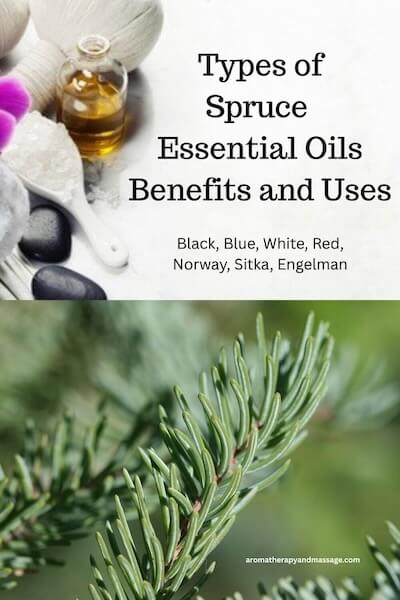- Home
- Essential Oil Profiles
- Spruce Essential Oils
As an affiliate for Bookshop, Amazon, and other programs, I may earn a small commission for products purchased through links. This doesn't affect the price you pay. Privacy policy and disclosures.
Search this site:
Types of Spruce Essential Oils and Their Benefits and Uses in Aromatherapy
Spruces are conifer trees of the genus (plant family) Picea. Spruce essential oils are typically steam-distilled from the tree's needles and twigs. Of the more than 30 species of the tree, ones most commonly distilled into essential oils include:

- Black spruce (Picea mariana)
- Blue spruce (Picea pungens)
- White spruce (Picea glauca, formerly Picea alba)
- Norway spruce (Picea abies)
- Engelman spruce (Picea engelmanii)
- Sitka spruce (Picea sitchensis)
- Red spruce (Picea rubens)
See separate articles on the black and blue oils. This article looks at the others listed. For more conifer essential oils, see pine (genus Pinus) and fir (genus Abies).
Spruce Essential Oils General Information
While spruce essential oils typically have similar benefits and uses, details vary based on an oil's specific composition. For skin use, patch test each oil to make sure you are not sensitive to it. Avoid old or oxidized oils because they may cause skin sensitization.
Is spruce safe to use during pregnancy? Sources vary on the answer to that question, and it may depend on the type of spruce. Consult a professional.
Are the oils safe for children? Likely, for kids 2+, but again specifics may vary by type of spruce oil. Some spruces may have a high camphor content and might only be appropriate for older children. Consult a professional.
White Spruce Essential Oil
White spruce (Picea glauca) has uses similar to black spruce but has no apparent restorative action on neuroendocrine-immune functions, according to Aromatica: A Clinical Guide to Essential Oil Therapeutics, Volume I. Instead, white spruce's higher monoterpene content makes for a more stimulating oil that in particular helps thin and break up mucus.
Main components: beta-pinene, alpha-pinene, bornyl acetate, (+)-limonene, camphene, according to Essential Oil Safety, 2nd Edition.
White spruce oil is stimulating, clarifying, and purifying with a middle to top perfume/aromatic note. The aroma is woody, fresh, piney, camphoraceous.
Respiratory Benefits: Inhaling the scent strengthens the respiratory tract, breaks up mucus, clears blocked sinuses, and soothes spasms.3 The oil helps support healthy lung and airway activity during respiratory ailments4,5 and helps relieve persistent coughing.6
Open your breath with a steam inhalation—add a drop of white spruce oil to hot water in a bowl. Lean over it, being careful of the heat, and inhale deeply for a few minutes.1
Musculoskeletal Benefits: This essential oil helps ease muscle tension, relieve muscle spasms, manage pain and inflammation, and soothe swollen lymph glands.4,5,6 To relieve sore muscles, use white spruce in a massage oil blend.2
Emotional/Mental Benefits: Emotionally white spruce is a stimulating, energizing essential oil useful for uplifting body and mind.4,5 The oil may relieve depression,3 promote mental clarity and enhance focus,7 and support a stronger self-image to help with strengthening personal identity.5 To refresh and uplift body and mind, diffuse white spruce alone or with a citrus oil.2
Skin Care: White spruce essential oil heals, nurtures, and rejuvenates the skin.5,6 Moisturize your skin with a white spruce body lotion to help move your body’s energy and encourage the detox process.1
Add 1–2% of white spruce to lotions, creams, or balms to help clarify and balance your skin. To promote a healthy, refreshed scalp and hair, add 1–2% of white spruce to your hair care products.8
Chakra Support: Use the oil for the second chakra (relationships, creation energy), fifth chakra (speaking truth), and sixth chakra (perspective).4
Sources:
1 https://www.aromatics.com/products/white-spruce-essential-oil
2 https://www.revive-eo.com/product/white-spruce/
3 https://jadebloom.com/spruce-white-essential-oil-therapeutic-grade-10ml.html
4 https://www.stillpointaromatics.com/white-spruce-Picea-glauca-essential-oil-aromatherapy
5 https://www.natureinbottle.com/product/white_spruce_essential_oil
6 https://www.lgbotanicals.com/White-Spruce-Essential-Oil_p_1243.html
7 https://gyalabs.com/blogs/essential-oils/benefits-uses-of-spruce-essential-oil
8 https://www.newdirectionsaromatics.com/oils/essential-oils/spruce-essential-oil-white
Norway Spruce (Picea abies)
Main components: beta-pinene, camphene, alpha-pinene, (+)-limonene, delta-3-carene, according to Essential Oil Safety, 2nd Edition.
The Complete Book of Essential Oils and Aromatherapy: Use Norway spruce for bronchitis, respiratory problems, physical fatigue, mental exhaustion, general aches and pains, acne, anxiety, and stress.
Nature in Bottle: Norway spruce supports healthy lung and airway activity, especially if you have congestion from a cold or flu. You can diffuse the essential oil to facilitate easy breathing. This oil may also boost the immune system and help with managing muscle spasms, pain, and inflammation.
Emotionally and energetically, Norway spruce balances the mind and body and is especially useful for relieving physical and emotional exhaustion. Inhaling the scent of this purifying and uplifting oil may reduce stress and help clear sadness, sluggishness, or mental fatigue.
Jade Bloom: Norway spruce essential oil rejuvenates you when fatigued, whether mentally, physically, or sexually. Diffusing the oil helps purify the air, and you can use the oil in cleaning blends. Other possible uses include:
- Respiratory support: asthma, bronchitis, colds, flu, sinusitis, sore throat.
- Pain relief: arthritis, gout, muscle soreness, neuralgia, sciatica.
- Skin care: psoriasis, eczema, ringworm, insect repellent.
Engelmann Spruce (Picea engelmanii)
The scent of Engelmann spruce essential oil is sweet, warm, pine-like, and woody, with camphoraceous and citrus notes, according to Essential Oils: A Comprehensive Handbook for Aromatic Therapy. The main components are beta-myrcene, alpha-pinene, camphor, camphene, and beta-pinene.
Aromatics: The light-hearted scent helps release heavy emotions and helps clear the breath and build resilient health during cold season. When you have a cold and need to open your breath, blend Engelmann spruce with black spruce and lime essential oils in an inhaler. You can also use the Engelmann spruce in a massage oil for muscles and joints or diffuse the oil to purify a room and support immunity.
Stillpoint Aromatics: Uses for Engelmann spruce:
- Respiratory blends, such as chest rubs, diffuser blends, or nasal inhalers. The oil may help boost the immune system.
- Deodorants, especially combined with Sitka spruce and pinon pine (Pinus edilus) essential oils.
- Rubs for muscle aches and pains, especially combined with black spruce and spike lavender (Lavandula latifolia) essential oils.
Energetically, this spruce oil is grounding, calming, and centering and supports mental, emotional, and spiritual clarity. Use for first chakra grounding and seventh chakra connection to higher information.
Sitka Spruce (Picea sitchensis)
The scent of Sitka spruce essential oil is typically coniferous, woody, and dry, with a camphoraceous element, according to Essential Oils: A Comprehensive Handbook for Aromatic Therapy. The main components are beta-pinene, beta-phellandrene, alpha-pinene, and bornyl acetate. This composition suggests using the oil for muscle inflammation and pain, respiratory inflammation and congestion, and stress, tension, and anxiety.
Aromatics suggests using the following uses for this top-middle note oil:
- For nighttime congestion, make an aromatherapy inhaler to open your breath and encourage rest.
- To help relieve coughs, blend Sitka spruce oil into a natural lotion. Massage onto your throat and chest.
- To relieve whole-body soreness and achy feelings, use Sitka spruce in a comforting body oil.
Nature in Bottle: Use Sitka spruce essential oil for all skin types in soaps, face washes, face masks, toners, and creams to firm and hydrate skin and give it a healthy glow. The essential oil balances and regulates oil production in the skin and hair.
Emotionally and energetically, this essential oil stimulates and clarifies the mind while balancing, uplifting, soothing, and strengthening the senses. Diffusing the oil at night encourages restful sleep. The oil also has an aphrodisiac quality.
Stillpoint Aromatics: Use the oil for the first chakra (survival and support), fourth chakra (unconditional love), fifth chakra (speaking truth), and seventh chakra (higher information, balancing, clarity, expansive, grounding, introspective, protective, transformative).
Red Spruce (Picea rubens)
Compared to the aroma of black spruce, the scent of red spruce essential oil is lighter, fresher, more coniferous, with underlying citrus notes, according to Essential Oils: A Comprehensive Handbook for Aromatic Therapy. Red spruce likely helps relieve pain and inflammation.
Main components: bornyl acetate, camphene, alpha-pinene, beta-pinene, (+)-limonene, camphor, delta-3-carene, according to Essential Oil Safety, 2nd Edition.
Buy essential oils from Aromatics International (recommended).
Rocky Mountain Essential Oils.
Spruce needle image credit: Arthur Chapman, CC BY 2.0, via Wikimedia Commons



